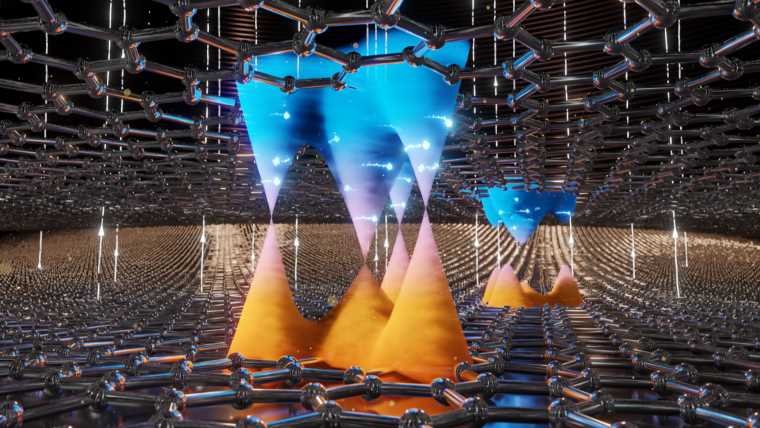An international team of researchers led by scientists at the University of Göttingen has confirmed the theory that electrons travel through naturally occurring bilayer graphene in the same way as light, without mass.
The experiments, which were aided by researchers from the Massachusetts Institute of Technology (MIT) and the National Institute for Materials Science (NIMS), also showed that unlike single-layer graphene, stacked bilayer graphene can be switched from conductive to insulating states. This finding could represent a significant breakthrough by removing one of the main barriers limiting the wider use of graphene.
Tantalizing Properties of Two-Dimensional Graphene
Graphene, a two-dimensional material made of a single layer of carbon atoms, was first discovered in 2004. While it was already known for its unusual electromagnetic properties, understanding exactly how electrons moved through this material had remained elusive. The most popular theory proposed back in 2009 suggested that they moved without mass, like light, which would account for much of graphene’s highly conductive properties.
Hoping to confirm this idea, the research team developed an experiment that involved stacking graphene in multiple layers. This included cooling the bilayer graphene down to cryogenic temperatures, or roughly 273° below freezing.
Significantly, the researchers point out that these experiments weren’t even possible back in 2009. Instead, they required a “significantly enhanced sample quality” of sample materials that simply wasn’t available 15 years ago. Fortunately, it is now 2024, and the folks at NIMS were able to produce the type of graphene the team needed.
Sure enough, by measuring the travel of electrons through the enhanced bilayer graphene and with the “close collaboration about theory with MIT,” they confirmed that they were moving like a particle without any mass similar to light.
“We were already aware of the theory,” explained Professor Thomas Weitz at Göttingen University’s Faculty of Physics. “However, now we have carried out experiments which actually show the light-like dispersion of electrons in bilayer graphene.”
“It was a very exciting moment for the entire team,” Weitz added.
Research Also Reveals an Insulating State in Bilayer Graphene
In their study, published in the journal Nature Communications, the researchers explain how graphene’s highly conductive properties have caused scientists to “dream” of using graphene for much faster and more energy-efficient transistors. Unfortunately, a transistor, which is essentially an electronic switch like the light switch in your house, must be able to be turned on and off. For all of its compelling EM properties, graphene has virtually no insulating state, meaning it is always in the “switched-on” position.
The researchers say they were pleasantly surprised to find that bilayer graphene didn’t have this limitation. Instead, their experiments into the dispersion of electrons in bilayer graphene showed that the application of an external electrical field switched the material to an insulating state. In effect, they could turn the material’s conductive switch from on to off.
“Two graphene layers, as found in the naturally occurring form of double-layer graphene, combine the best of both worlds,” the researchers explain, “a structure that supports the amazingly fast motion of electrons moving like light as if they had no mass, in addition to an insulating state.”
The research team concedes that their experiments were conducted at extremely cold temperatures in a laboratory setting rather than at room temperature. However, they believe future research could expand that temperature range enough to make bilayer graphene a viable candidate for the creation of ultra-efficient transistors and other electronic devices that take advantage of the material’s unique properties.
“Our work is very much a first step but a crucial one,” said Dr. Anna Seiler, a postdoctoral researcher at Göttingen University and the paper’s first author. “The next step for researchers will be to see if bilayer graphene really can improve transistors or to investigate the potential of this effect in other areas of technology.”
Christopher Plain is a Science Fiction and Fantasy novelist and Head Science Writer at The Debrief. Follow and connect with him on X, learn about his books at plainfiction.com, or email him directly at christopher@thedebrief.org.

